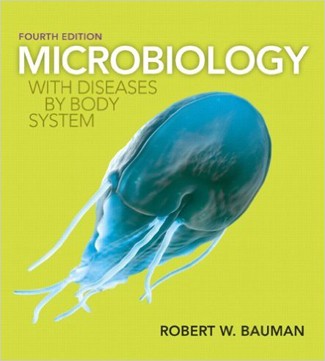Microbiology with Diseases by Body System 4th Edition Bauman Test Bank
Microbiology with Diseases by Body System 4th Edition Bauman Test Bank
$35.00
Description
978-0321918550
Microbiology with Diseases by Body System, 4e (Bauman)
Chapter 4 Microscopy, Staining, and Classification
4.1 Multiple Choice Questions
1) A useful unit for measuring the size of most cells is
A) nanometers.
B) millimeters.
C) micrometers.
D) centimeters.
E) decimeters.
Answer: C
Bloom’s Taxonomy: Knowledge
Section: Units of Measurement
Learning Outcome: 4.1
2) Which of the following is an INCORRECT pairing?
A) magnification; refraction of radiation
B) contrast; staining techniques
C) numerical aperture; curved glass
D) dark field:high contrast
E) electron beams; shorter wavelength
Answer: C
Bloom’s Taxonomy: Comprehension
Section: Microscopy
Learning Outcome: 4.4, 4.8
3) The ability of a lens to gather light is referred to as its
A) resolution.
B) numerical aperture.
C) refraction.
D) contrast.
E) magnification.
Answer: B
Bloom’s Taxonomy: Knowledge
Section: Microscopy
Learning Outcome: 4.6
4) Which of the following are magnifying lenses?
A) objectives
B) oculars
C) condensers
D) dark-field stops
E) both objectives and the oculars
Answer: E
Bloom’s Taxonomy: Application
Section: Microscopy
Learning Outcome: 4.8
5) The light source in a ________ microscope is ultraviolet (UV) light.
A) phase-contrast
B) dark-field
C) fluorescent
D) Nomarski
E) bright-field
Answer: C
Bloom’s Taxonomy: Comprehension
Section: Microscopy
Learning Outcome: 4.10
6) Why does immersion oil improve resolution?
A) It allows light to travel at a uniform speed on its way to the lens.
B) It decreases the working distance.
C) It increases the numerical aperture.
D) It increases numerical aperture and maintains a uniform light speed.
E) It increases the angle of refraction of the light.
Answer: D
Bloom’s Taxonomy: Application
Section: Microscopy
Learning Outcome: 4.6
7) You are shown a micrograph from a light microscope in which the specimens appear bright compared to the background. The micrograph is probably from a(n) ________ microscope.
A) dark-field
B) phase-contrast
C) Nomarski
D) bright-field
E) atomic force
Answer: A
Bloom’s Taxonomy: Application
Section: Microscopy
Learning Outcome: 4.9
8) Unstained cells that lack pigment are best observed on the ________ microscope.
A) bright-field
B) phase-contrast
C) scanning electron
D) scanning tunneling
E) transmission electron
Answer: B
Bloom’s Taxonomy: Comprehension
Section: Microscopy
Learning Outcome: 4.9
9) High resolution images of the internal structures of microbial cells are obtained using ________ microscopes.
A) atomic force
B) scanning tunneling
C) transmission electron
D) confocal
E) scanning electron
Answer: C
Bloom’s Taxonomy: Comprehension
Section: Microscopy
Learning Outcome: 4.11
10) Lasers are used to generate the images produced by ________ microscopes.
A) fluorescent
B) confocal
C) phase-contrast
D) atomic force
E) both confocal and atomic force
Answer: D
Bloom’s Taxonomy: Comprehension
Section: Microscopy
Learning Outcome: 4.10, 4.11
11) Which of the following microscopes produces the highest resolution images?
A) dark-field
B) differential interference
C) scanning electron
D) fluorescent
E) atomic force
Answer: E
Bloom’s Taxonomy: Knowledge
Section: Microscopy
Learning Outcome: 4.11
12) If a microbiology lab student left the safranin out of the Gram stain procedure, what would be the result?
A) All cells would be purple.
B) Gram-positive cells would be purple and Gram-negative cells would be colorless.
C) All cells would be pink.
D) Gram-positive cells would be pink and Gram-negative cells would be purple.
E) Gram-positive cells would be colorless and Gram-negative cells would be pink.
Answer: B
Bloom’s Taxonomy: Application
Section: Staining
Learning Outcome: 4.15
13) All of the following are common to both the Gram stain and the acid-fast stain EXCEPT
A) primary stain.
B) counterstain.
C) a decolorizing agent.
D) a chemical mordant.
E) a decolorizing agent and a counterstain.
Answer: D
Bloom’s Taxonomy: Application
Section: Staining
Learning Outcome: 4.15
14) Safranin dye is used as the counterstain in ________ stain(s).
A) the Gram
B) the endospore
C) the acid-fast
D) the flagellar
E) both the Gram and the endospore
Answer: E
Bloom’s Taxonomy: Application
Section: Staining
Learning Outcome: 4.15
15) Heat is used to drive the stain into cells in the ________ staining procedure(s).
A) endospore stain
B) acid-fast stain
C) capsule stain
D) Gram stain
E) both acid-fast and endospore stains
Answer: E
Bloom’s Taxonomy: Comprehension
Section: Staining
Learning Outcome: 4.13
16) The acid-fast stain is used to stain
A) bacteria with waxy cell walls.
B) bacteria lacking cell walls.
C) living bacteria.
D) endospores.
E) bacteria with capsules.
Answer: A
Bloom’s Taxonomy: Comprehension
Section: Staining
Learning Outcome: 4.15
17) A sample is prepared using osmium tetroxide as a stain. This sample has been prepared for a(n) ________ microscope.
A) electron
B) phase-contrast
C) atomic force
D) fluorescence
E) differential interference contrast
Answer: A
Bloom’s Taxonomy: Application
Section: Staining
Learning Outcome: 4.16
18) The kingdoms included in the Linnaeus system of classification are
A) Animalia and Prokaryotae.
B) Protista and Plantae.
C) Fungi and Protista.
D) Animalia and Plantae.
E) Prokaryotae and Protista.
Answer: D
Bloom’s Taxonomy: Comprehension
Section: Classification and Identification of Microorganisms
Learning Outcome: 4.21
19) The rules of naming organisms are called
A) taxonomy.
B) nomenclature.
C) classification.
D) binomials.
E) identification.
Answer: B
Bloom’s Taxonomy: Knowledge
Section: Classification and Identification of Microorganisms
Learning Outcome: 4.20




Reviews
There are no reviews yet.